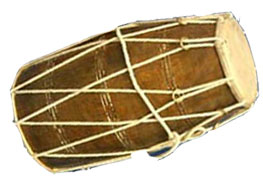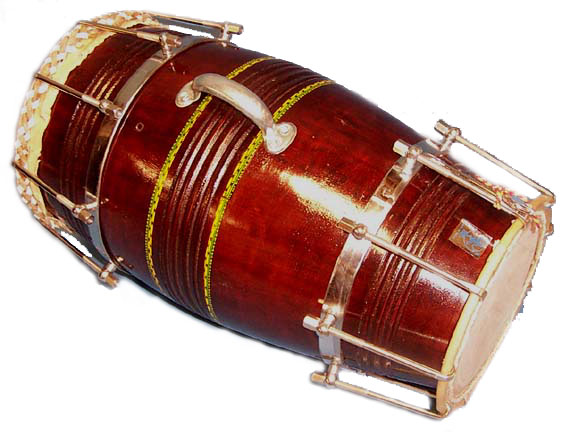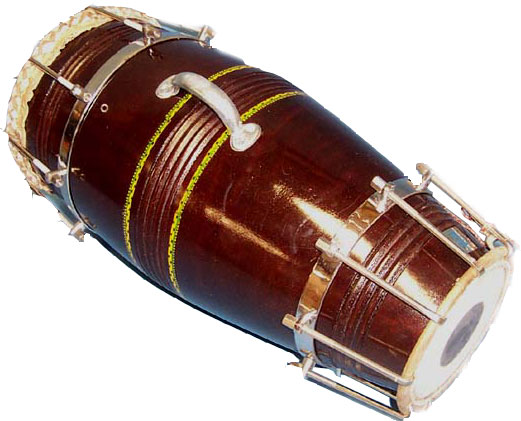
or call 1-800-RAG-MALA


Dholak (delux) - Chord tension - Price: $150.00
(Catalog#: BRDHDX) Cord and Ring 9"x18" Deluxe, Wooden two-headed drum. Heads held in place and tuned by cords and rings. Held horizontally, both heads are played. Made in IndiaShipping Weight: 11.00 lbs.
The dholak is one of the most widely utilized drums in the folk music of India. It has also found a permanent home in most of the recording and broadcast environments. Applications range from dance music such as bhangra and garba to devotional bhajans and keertans. It is not used for classical music where the tabla and pakhavaj reign supreme.
The dholak is basically a double headed drum with the bass head on one side and the treble head on the other. There is some form of putty applied on the inside of the bass head to give the head its lower tone. Invariably, when I've received a drum for sale at our music store, I have had to either replace this putty or replace the head. The one put on by the Indian makers falls off for some reason. It is possible to get a hold of this putty from a store and replace it. It's a paste made out of some tar etc. Some folk over the net have recommended butyl rubber caulk or some clear permanently flexible caulk as an alternative but we haven't given it a shot yet. Basically, Putting anything on a skin lowers its pitch and hence gives it a deep bass sound. Please try these suggestions at your own risk. One of these days I will try it and put the feedback here.
On the treble drum side, there is no putty added. It's just a thin goat skin head which when tuned up has a relatively dull but somewhat high pitched sound. To tune it, the rings on the chords have to be pulled and as the two chords are pulled closer together, the pitch of the drum will rise. Most good dholak players will try tuning this head to the tonic, 5th or 4th of the song. Many don't bother to do this their reasoning being that the dull tone hides the pitch and hence can be played without worrying about exact tunings.

or call 1-800-RAG-MALA


The Nut and Bolt tension Dholak (Delux) - Price: $225.00
(Catalog#: BRDHNB ) Dholak, Nut and Bolt Wooden two-headed drum. Heads held in place and tuned by bolts. Held horizontally, both heads are played. Made in India. Shipping Weight: 11.00 lbs.The nut and bolt version of the dholak is a more modern and better engineered version of the Dholak. Some even call this version a dholki although in this article I am reserving this name for the Naal mentioned below.
The treble head rim is designed so that the hooks can fit better. The tone on this drum I have found to be easier to control then the chord tension one. This is because in the Chord tension dholak, the same chord does the job of tuning both the drum heads. Whereas in the Nut and Bolt variety, each head gets its own tuning mechanism. The result is that you can tune the heads a bit more precisely. The treble head can go higher and be brighter sounding and the best part, changing the heads are a snap.

or call 1-800-RAG-MALA


Dholki or Naal - Price: $225.00
(Catalog#: BRNALX) Bolt Tension Deluxe model. Wooden two-headed drum. Heads held in place and tuned by bolts. Held horizontally, both heads are played. Made in India. Shipping Weight: 19.00 lbs.This is the same as the Dholak shown above except The heads are a bit more developed. The Bass head is designed more like a tabla head with multi layered skins the paste is still on the inside of the bass head, But on the treble head side, there is visible paste applied on the outside of the head similar to the talbe giving this drum a really nice high pitched tone reminicent to a high pitched tabla drum although not as resonant. In any case, the combination of the bass and treble tones is very pleasing. Like the dholak this drum is also used more in the folk, filmi, bhajan, keertan setting.
In the drum shown above, the heads are kept in place by metal hooks that have nuts at the bottom that can be tightened or loosened to adjust the pitch of the head. This makes changing the heads very quick. Caution is advised when tuning as it is very easy to tighten the nuts too much resulting in head breakage.